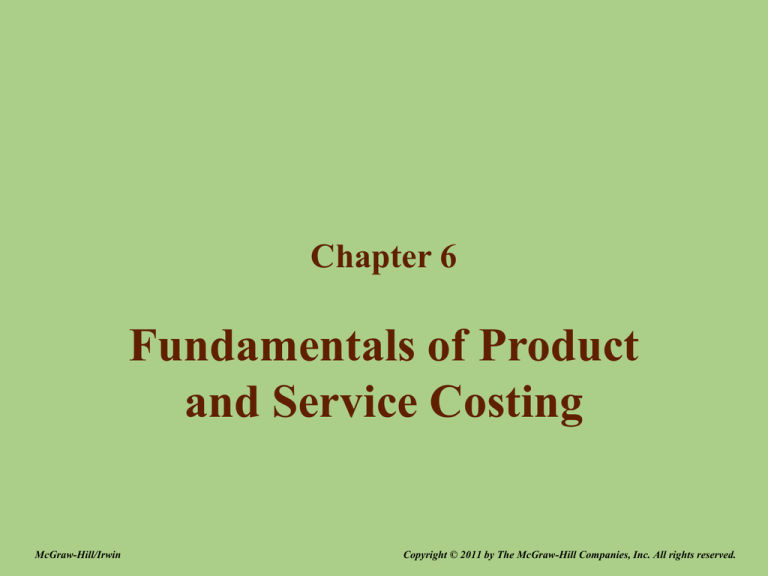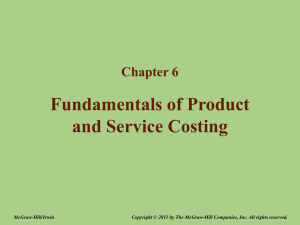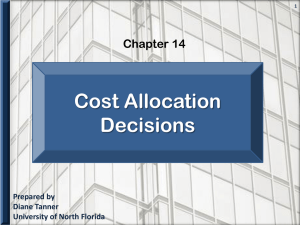
Chapter 6
Fundamentals of Product
and Service Costing
McGraw-Hill/Irwin
Copyright © 2011 by The McGraw-Hill Companies, Inc. All rights reserved.
Learning Objectives
L.O. 1 Explain the fundamental themes underlying
the design of cost systems.
L.O. 2 Explain how cost allocation is used in a cost
management system.
L.O. 3 Explain how a basic product costing system works.
L.O. 4 Understand how overhead cost is allocated to products.
L.O. 5 Explain the operation of a two-stage allocation system
for product costing.
L.O. 6 Describe the three basic types of product costing systems:
job order, process, and operations.
6-2
Cost System
Keys to a good cost system:
• Oriented to the needs of the decision makers
• Designed so that benefits exceed costs
6-3
Cost Management Systems
L.O. 1 Explain the fundamental themes underlying
the design of cost systems.
• The objective of the cost management system
is to provide information about costs relevant
for decision making.
• The cost system accumulates and reports costs
about processes, products, and services.
6-4
LO1
Reasons to Calculate Product
or Service Costs
• For decision making
• For deciding what to sell
• For setting prices
• For knowing the cost of goods sold
• For knowing the cost of inventory
6-5
Cost Allocation and Product Costing
L.O. 2 Explain how cost allocation is used
in a cost management system.
Basic Cost Flow Diagram
Cost
pools
Direct
materials
Direct
labor
Manufacturing
overhead
Indirect
Cost
allocation
rule
Cost
objects
(allocated
by direct
labor cost)
Direct
Alpha
Beta
6-6
LO2
Fundamental Themes Underlying
the Design of Cost Systems
• Cost systems should have a decision focus.
• Different cost information is used for
different purposes.
• Cost information for managerial purposes
must meet the cost-benefit test.
6-7
Basic Cost Flow Model
L.O. 3 Explain how a basic product costing system works.
• How costs and units move through inventories:
Beginning
balance
+
Transfers
in
–
Transfers
out
=
Ending
balance
BB
+
TI
–
TO
=
EB
• This is true for the following accounts:
– Raw Materials (RM)
– Work-in-Process (WIP)
– Finished Goods (FG)
6-8
LO3
Costing with No Work-in-Process
Inventories
• Baxter Paint begins production on April 1.
• It starts and completes production of 100,000
gallons of paint in April and has no ending
work-in-process inventory.
Cost of resources used in April:
Materials
Labor
Manufacturing overhead
Total
$ 400,000
100,000
500,000
$1,000,000
6-9
LO3
Costing with No Work-in-Process
Inventories
BB
0
+
TI
–
TO
=
100,000
100,000
+
–
=
gallons
gallons
EB
0
FG
6-10
LO3
Costing with No Work-in-Process
Inventories
• What are the costs at the end of the period?
• $1,000,000 was added to work-in-process
and then transferred out to finished goods.
• Since Baxter produced 100,000 gallons of
paint, then the cost per gallon of paint is $10.
6-11
LO3
Costing with Work-in-Process
Inventories
Production for Baxter Paint for May follows (gallons):
Beginning inventory
Started in May
Total
Ending WIP (50% complete)
Transferred out
-0110,000
110,000
20,000
90,000
6-12
Costing with Work-in-Process
Inventories
LO3
BB
0
+
TI
–
110,000
+
–
gallons
TO
90,000
gallons
=
EB
20,000 gallons
=
(50% complete)
FG
6-13
LO3
Costing with Work-in-Process
Inventories
• How do we cost Baxter’s 20,000 gallons of paint that
are only half finished?
• 20,000 gallons half finished is equivalent to 10,000
gallons finished.
• 90,000 gallons transferred out plus 10,000 equivalent gallons
of finished paint equals 100,000 equivalent gallons of paint.
Gallons of paint transferred out
Equivalent gallons of finished paint
Total equivalent gallons of paint
90,000
10,000
100,000
6-14
LO3
Costing with Work-in-Process
Inventories
Costs incurred in May:
Materials
Labor
Manufacturing overhead
Total
$390,000
100,000
500,000
$990,000
$990,000/100,000 gallons = $9.90 per gallon
90,000 gallons × $9.90/gallon = $891,000
6-15
LO3
Costing with Work-in-Process
Inventories
Direct material + Direct labor + Overhead
($990,000)
90,000
gallons
(90%)
Equivalent gallons
Finished goods
inventory
$891,000
10,000
gallons
(10%)
Work-in-process
inventory
$99,000
6-16
LO3
Costing in a Multiple Product,
Discrete Process Industry
Cost Flow Diagram: Cost Allocation Bases—Grange Boats
Cost
pools
Direct
materials
Direct
cost
Direct
labor
Manufacturing
overhead
Direct
cost
Indirect
cost
(allocated in
proportion to
direct labor-hours)
Cost
objects
C-27s
C-20s
6-17
LO3
Costing in a Multiple Product,
Discrete Process Industry
Data for January—Grange Boats
Units produced
Direct labor-hours
Costs:
Direct materials
Direct labor
Manufacturing overhead
Total
C-27s
C-20s
Total
10
2,000
30
3,000
40
5,000
$40,000
72,000
$36,000
78,000
$ 76,000
150,000
180,000
$406,000
6-18
Costing in a Multiple Product,
Discrete Process Industry
LO3
Cost
pools
Direct
materials
Direct
labor
$76,000
$150,000
Direct cost
Cost
objects
Direct cost
C-27s
C-20s
$40,000
$36,000
$72,000
$78,000
6-19
Predetermined Overhead Rates
L.O. 4 Understand how overhead cost is allocated to products.
• Indirect costs are allocated using a predetermined
overhead rate (POHR).
• POHR is the cost per unit of the allocation base used
to charge overhead to products.
POHR = $ ÷ Base
6-20
LO4
Predetermined Overhead Rates
What are the estimated costs?
POHR
=
Estimated overhead $
Estimated allocation base
What activity drives the overhead costs?
• Why use estimates?
• Products need to have costs applied
during the period.
• The exact amount of indirect costs are
not known until the end of the period.
6-21
LO4
Predetermined Overhead Rates
Direct labor hours
Estimated overhead costs
C-27s
C-20s
2,000
3,000
Total
5,000
$180,000
POHR = $180,000 ÷ 5,000 = $36/DLH
6-22
LO4
Product Costing of Multiple Products
Cost
pool
Manufacturing
overhead
$180,000
Cost
allocation
rule
Direct labor hours ($36/DLH
Cost
objects
C-27s
$72,000
(2,000 DLH × $36)
C-20s
$108,000
(3,000 DLH × $36)
6-23
LO4
Product Costing of Multiple Products
Product Costs for January—Grange Boats
(allocation base is direct labor hours)
C-27s
C-20s
Total
Units produced
Direct labor-hours
Costs:
Direct materials
Direct labor
Manufacturing overhead
(@ $36/hour)
Total
$ 40,000 $ 36,000 $ 76,000
72,000
78,000 150,000
Cost per unit
$ 18,400 $
10
2,000
30
3,000
40
5,000
72,000 108,000 180,000
$184,000 $222,000 $406,000
7,400
6-24
LO4
Choice of the Allocation Base
• The choice of the allocation base is somewhat arbitrary.
• What will be the result if management chooses direct
labor cost as the allocation base?
• The rate then becomes 120% ($180,000 ÷ $150,000)
6-25
LO4
Choice of the Allocation Base
Product Costs for January—Grange Boats
(allocation base is direct labor dollars)
C-27s
C-20s
Total
Units produced
Direct labor-hours
Costs:
Direct materials
Direct labor
Manufacturing overhead
(@ 120%)
Total
$ 40,000 $ 36,000 $ 76,000
72,000
78,000 150,000
Cost per unit
$ 19,840 $
10
2,000
30
3,000
40
5,000
86,400
93,600 180,000
$198,400 $207,600 $406,000
6,920
6-26
Multiple Allocation Bases
and Two-Stage Systems
L.O. 5 Explain the operation of a two-stage allocation
system for product costing.
• We can use two or more allocation bases to allocate
manufacturing overhead to products.
6-27
LO5
Cost
pool
Multiple Allocation Bases
and Two-Stage Systems
Manufacturing overhead
First stage
Machine-related
costs
Direct labor-related
costs
Cost
allocation
rules
Indirect costs
Indirect costs
(allocated in proportion
to machine hours)
(allocated in proportion
to direct labor costs)
Cost
objects
C-27s
C-20s
Second
stage
6-28
Multiple Allocation Bases
and Two-Stage Systems
LO5
Overhead
$180,000
Cost
pool
Intermediate
cost pools
Labor-related
$108,000
Machine-related
$72,000
Cost allocation
rule
Direct labor
costs
Machine
hours
6-29
LO5
Multiple Allocation Bases
and Two-Stage Systems
• Burden rates:
$72,000 ÷ 4,000 machine hours = $18
$108,000 ÷ $150,000 labor costs = 72%
6-30
LO5
Two-Stage Cost Allocation—
Grange Boats
Intermediate
cost pools
Labor-related
$180,000
Machine-related
$72,000
Cost
Allocation
$150,000
Direct labor cost
72% DLC
4,000
Machine hours
$18/MH
C-27s
$51,840 DL cost
$18,000 MH
C-20s
$ 56,160 DL cost
$ 54,000 MH
$69,840 Total
$110,160 Total
Cost
Objects
Allocated
overhead
6-31
LO5
Two-Stage Cost Allocation—
Grange Boats
C-27s
C-20s
Total
Costs:
Direct materials
$ 40,000 $ 36,000 $ 76,000
Direct labor
72,000
78,000 150,000
Overhead:
Machine-related
@$18/machine-hour
18,000
54,000
72,000
Labor-related
51,840
56,160 108,000
@72% direct labor cost $ 69,840 $110,160 $180,000
Total cost
$181,840 $224,160 $406,000
Unit cost
$ 18,184 $
7,472
6-32
Product Costing Systems
L.O. 6 Describe the three basic types of product costing
systems: job order, process, and operations.
• Job costing:
– An accounting system that traces costs to individual units
or to specific jobs, contracts, or batches of goods.
(custom homes, movies, services)
• Process costing:
– An accounting system used when identical units are
produced through a series of uniform production steps.
(cornflakes, facial tissues, paint)
6-33
LO6
Product Costing Systems
• Operation costing:
– A hybrid costing system often used in manufacturing
of goods that have some common characteristics
plus some individual characteristics.
(automobiles, computers, clothing)
6-34
End of Chapter 6
McGraw-Hill/Irwin
Copyright © 2011 by The McGraw-Hill Companies, Inc. All rights reserved.




